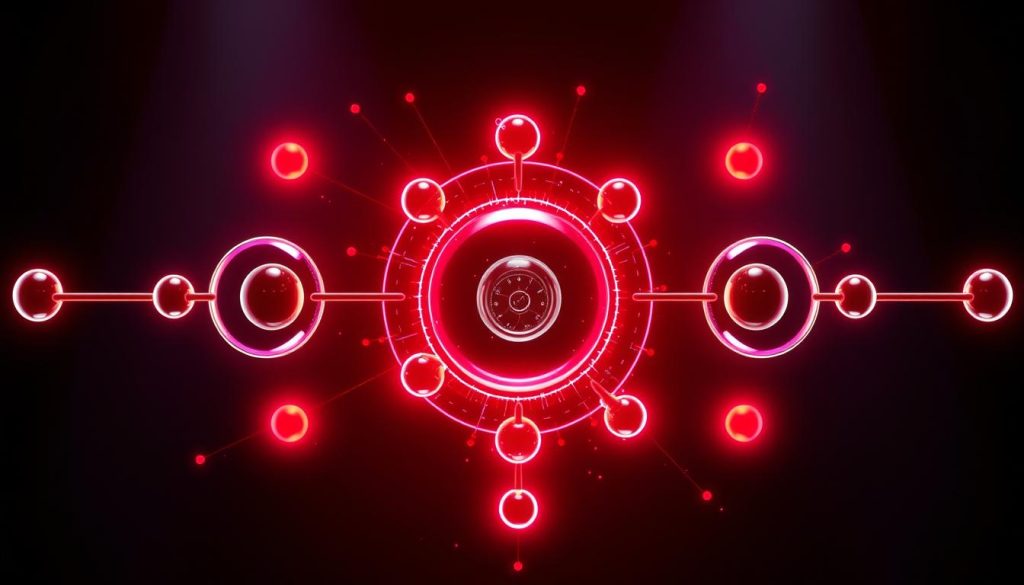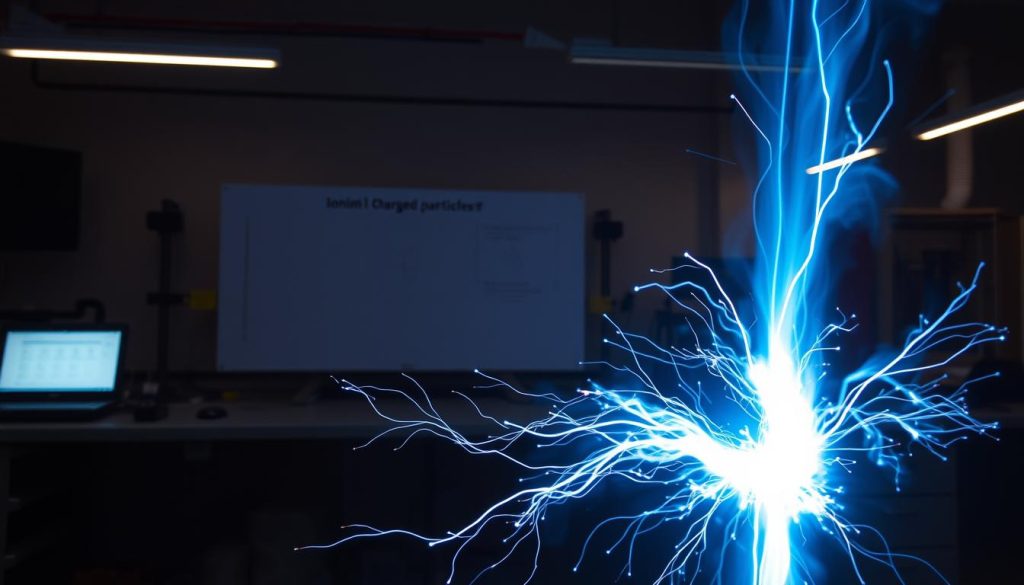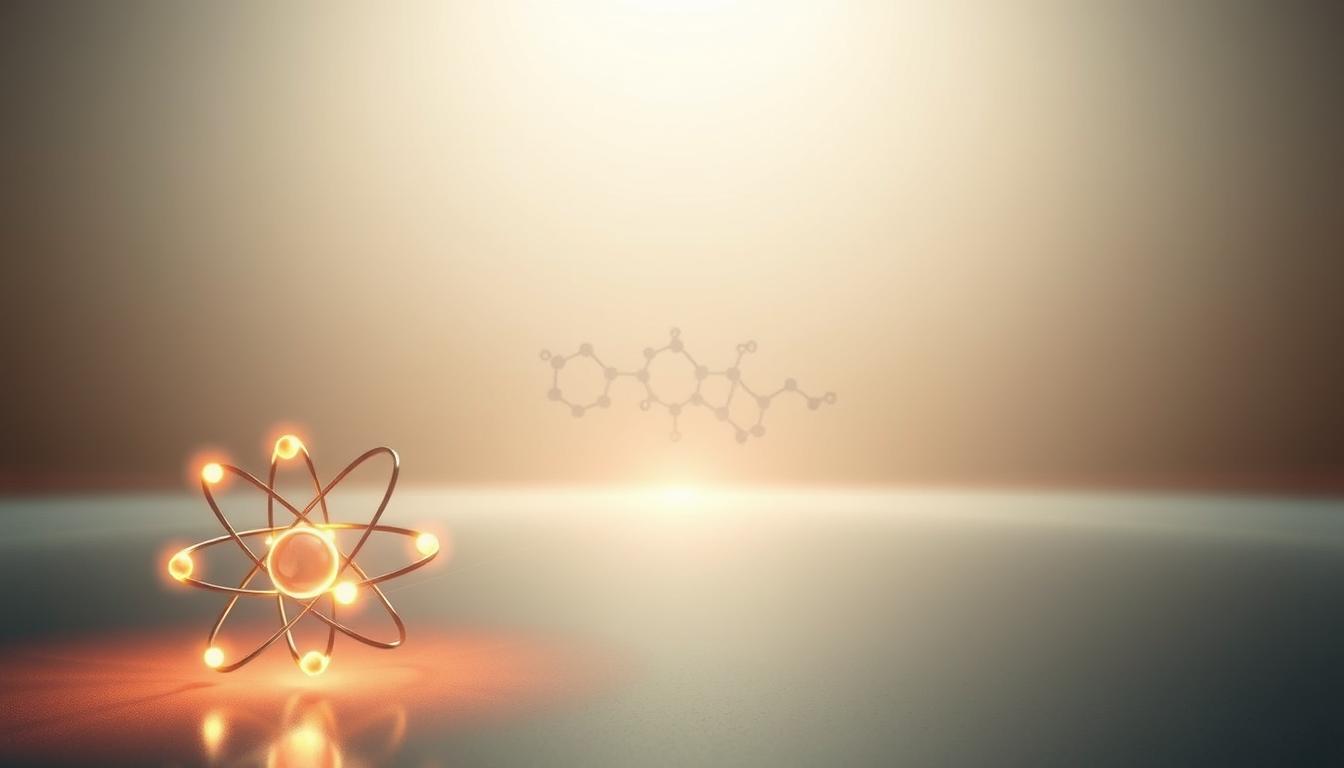The ionization process is key to many scientific discoveries and industrial uses. It happens when atoms or molecules either gain or lose electrons. This basic reaction is vital for understanding chemistry and physics.
It also helps us see how industries use it in real ways. Knowing about ionization lets us explore atomic interactions and molecular science better. This knowledge opens up new chances for progress in many areas.
Understanding Ionization: A Basic Definition
Ionization is a key chemical reaction in many natural and scientific areas. It turns neutral particles into charged particles, or ions. This change can happen when particles meet or when they get energy from heat or light.
The new ions help conduct electricity and affect chemical reactions. This is important in many fields.
Definition of Ionization
The ionization process is about changing an atom or molecule’s charge. This can happen when it gets hot or when it meets ionizing radiation. Knowing about ions helps us understand things like auroras and lightning.
It also explains how things like smoke detectors work.
Historical Context and Discoveries
The study of ionization started in the late 19th and early 20th centuries. Scientists like J.J. Thomson and Ernest Rutherford made big discoveries. Thomson found the electron, and Rutherford learned about the atomic nucleus.
Together, they showed how important ions are. Their work helped physics and chemistry grow a lot.
The Science Behind Ionization
Ionization changes an atom’s structure. It happens when atoms lose or gain valence electrons. This change is key to creating ions, which are important in many natural and industrial processes.
Atomic Structure and Ionization
The ionization process starts with an atom’s structure. Atoms have a nucleus and electrons in energy levels or shells. When an electron is added or removed, an ion is formed.
This process is vital for understanding many chemical reactions. Knowing how atoms work helps us understand ionization better.
Ionic vs. Covalent Bonds
Bonding types affect a molecule’s stability and properties. Ionic bonds form when electrons are transferred from one atom to another. This usually occurs between metals and non-metals.
It results in stable ions with high melting and boiling points. On the other hand, covalent bonds happen when atoms share electrons. This is common between non-metal atoms.
It leads to molecules with lower melting and boiling points. These molecules are more flexible in reactions.

Ionization Process Steps
The ionization process starts with energy that overcomes the electron’s binding energy. Many techniques are used to introduce this energy. Let’s explore these steps and the processes involved.
Step-by-Step Breakdown
Here’s how the ionization process works:
- Introduction of Energy: First, energy like heat, light, or electricity is added.
- Excitation of Electrons: This energy makes electrons jump to higher energy levels.
- Overcoming Binding Energy: Enough energy lets electrons break free from the nucleus.
- Formation of Ions: When electrons leave, they create positively charged ions and free electrons.
Types of Ionization Processes
There are various ways to ionize atoms. Here are some examples:
- Thermal Ionization: Heating atoms until they ionize is a common method.
- Impact Ionization: High-energy particles colliding with atoms also ionize them.
- Photoionization: High-energy photons, like UV light, can remove electrons.
- Field Ionization: A strong electric field near a sharp point can ionize atoms.
Different techniques use different energy sources. This shows how diverse ionization can be. Each method has its own benefits, depending on the situation.
Examples of the Ionization Process
The ionization process is key in chemistry and physics. It shows how important and versatile it is. By looking at examples, we see how ionization helps in science and everyday life.
Ionization in Chemistry
In chemistry, ionization happens in chemical reactions. A well-known example is when sodium (Na) and chlorine (Cl) make sodium chloride (NaCl). Sodium loses an electron to chlorine, creating positive sodium ions (Na+) and negative chloride ions (Cl–). This is basic in many chemical reactions and is crucial in inorganic chemistry.

Ionization in Physics
In physics, ionization has its own set of examples. For instance, it’s vital for electricity in gases, like in neon lights and gas discharge tubes. It’s also key in plasmas, which are ionized gases in stars and lightning. These examples show how ionization leads to new technologies and helps us understand nature.
Looking at these examples, we get a full picture of ionization’s role. It’s essential in both chemical reactions and physical phenomena.
How Does the Ionization Process Work?
To understand ionization, we need to look at ionization energy and the process’s pathways. Ionization turns a neutral atom or molecule into an ion by adding or removing electrons. This process is key in science and industry.
Energy Requirements
Ionization energy is the minimum energy needed to remove an electron from a gas atom or ion. This energy changes with each element. For example, noble gases have high ionization energy because their electrons are stable. On the other hand, alkali metals have lower ionization energy.
Here’s a look at the ionization energy for a few elements:
| Element | Ionization Energy (eV) |
|---|---|
| Helium | 24.6 |
| Lithium | 5.4 |
| Neon | 21.6 |
| Sodium | 5.1 |
Mechanisms and Pathways
Ionization has different ways to happen. High-energy particles can knock out electrons, creating ions. The photoelectric effect also works, where photons give energy to electrons, making them leave. Quantum tunneling lets electrons escape without enough energy.
Understanding ionization energy and the different pathways helps us see how ionization works.
The Importance of the Ionization Process in Everyday Life
The ionization process is crucial in our daily lives. It’s found in many things we use every day. For example, air purifiers use ionization to clean the air we breathe.
Fluorescent lights also rely on ionization. They ionize gases to produce light, using less energy than old bulbs. This saves energy and cuts down on electricity costs.

Our bodies also use ionization. It helps our cells work right, like sending signals and keeping fluids balanced. This shows how important ionization is for our health.
Ionization helps in many other ways too. It’s used in systems to check the air for pollutants. It also helps keep food fresh longer by using ionizing radiation. Plus, it affects the weather, influencing rain and storms.
So, ionization is key to a better, safer life. Learning about it helps us see its big impact on our world.
Applications of Ionization in Industry
In today’s world, ionization is key in many industries. It uses advanced tech to boost efficiency, accuracy, and safety. Let’s explore its uses in electronics and medicine.
Ionization in Electronics
Ionization tech is vital in making semiconductors and microchips. These parts are crucial for gadgets like phones and computers. It ensures top-notch quality, making it essential for making things.
It also stops static electricity, which can harm electronics. By fixing charge imbalances, it helps gadgets last longer and work better.
Ionization in Medicine
Ionization has big roles in medicine. It’s used in CT scans to see inside the body. It’s also key in radiation therapy to fight cancer.
It helps make sure medical tools and places are clean. This keeps patients safe. Plus, it helps make medical tools and devices with high precision.
Common Misconceptions About Ionization
Ionization is often misunderstood, leading to confusion. By debunking these myths, we can clear up the truth about this important process.
Myths vs. Facts
Many think ionization always means harmful radiation. This fear is not justified. In fact, not all ionization is harmful. For example, lightning strikes create both positive and negative ions naturally.
Another myth is that ionization is only man-made. But, it’s a natural process in nature and even in our bodies. Events like cosmic rays and our body’s biochemical processes involve ionization safely.
Clarifications and Corrections
To correct these misconceptions, we need to share the facts about ionization. Ionization itself is neutral and can be good or bad, depending on the situation. For instance, air purifiers use ionization to clean the air, showing its positive side.
It’s also important to note that not all ionization leads to harmful radiation. While some processes, like nuclear reactions, do, many natural ones do not. By understanding this, we can see the true value of ionization in both nature and technology.
Modern Advancements in Ionization Research
In recent years, ionization research has made huge strides, changing many scientific fields. These changes come from better mass spectrometry, quantum computing, and nanotechnology. Now, scientists can detect new materials with special electrical properties thanks to these advances.
Mass spectrometry has gotten much better, helping scientists analyze complex chemicals more accurately. Quantum computing has also made big leaps, thanks to better ionization control. This is key for creating stable qubits. Nanotechnology has also improved, leading to materials with amazing electrical properties.
These advances show how crucial ionization research is for science and technology. As scientists keep improving these methods, we can expect more breakthroughs. This will lead to new discoveries and innovations across many industries.
Future Prospects of the Ionization Process
The future of ionization is full of promise, set to change many fields and tackle big global issues. Research is making great strides, making the future of ionization look very bright. This is true for areas like sustainable energy, where fusion reactors are key.
These reactors need ionization to work well, aiming for clean, endless energy. This could change how we power our world.
In medicine, the outlook is also promising. New treatments for cancer are using ionization to be more precise and effective. This method helps target cancer cells without harming healthy ones. It offers a glimmer of hope for better, less painful treatments.
Looking to space, ionization’s role is just as exciting. It’s being explored for better space travel and keeping spacecraft running smoothly. This innovation could help us explore more of space with better technology. It’s not just about reaching new places; it’s about the tech advancements it brings.

